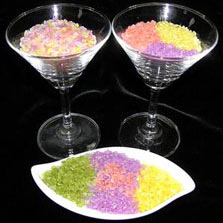Taiwan produces 7-color rice
Recently, Taiwan's rice market has always been volatile because the price of imported rice from abroad into Taiwan is 4-5 times cheaper than locally produced rice. In addition, the quality of imported rice is also better than that produced by Taiwanese farmers.
With the goal of competition and attracting domestic consumers, Taiwanese scientists have developed a new type of rice that promises not only delicious but also delicious eyes.
 (Photo: comcast.net) Taiwanese researchers have spent four years creating new rice varieties with seven colors: purple, black, blue, yellow, red, orange and white. The idea of developing this 7-color rice comes from a survey based on Taiwanese consumers' comments about local rice varieties. Most of them said that traditional rice varieties of Taiwan were " pale, bland and boring ".
(Photo: comcast.net) Taiwanese researchers have spent four years creating new rice varieties with seven colors: purple, black, blue, yellow, red, orange and white. The idea of developing this 7-color rice comes from a survey based on Taiwanese consumers' comments about local rice varieties. Most of them said that traditional rice varieties of Taiwan were " pale, bland and boring ".
Taiwanese rice producers are facing fierce competition with imports from abroad, so researchers hope that this colorful rice will attract consumers back to local products. .
Lo Tze - yen - a scientist from Hualien Agricultural Research Institute, who is also one of the authors of 7-color rice, said: "The color is extracted from natural, nutritious fruits and Each color corresponds to a different source of nutritional supplements, in particular, yellow rice contains Canana ginseng extract and is believed to reduce stress and increase resistance, while green rice can Extract of vitamin-rich root vegetables that lower blood pressure and protect cardiovascular ".
However, scientists also recommend that consumers should not wash rice if they do not want to lose color. Many people are concerned that this new type of rice will not be able to preserve for a long time because of its color. However, scientists have confirmed that the color of rice is extracted from the natural, so it is less likely to be moldy and ensure absolute safety for consumers. It is expected that this new rice will be marketed on the occasion of New Year 2007.
But consumers may find it difficult to eat this new rice because the ginseng rice is priced at 6 USD / kg, 5 times more than regular rice.
- Taiwan successfully developed multicolored rice
- Soft rice for the elderly
- Why does rice for overnight change red?
- Taiwan will produce paper from rice and wheat
- China produces rice varieties higher than human heads for high productivity
- Gene helps increase rice yield and quality
- China successfully bred purple rice for cancer treatment
- Looking for rice varieties
- China successfully researched 'sea rice', capable of raising 80 million people
- The journey of creating the best rice in the world by engineer Ho Quang Cua
- Successful restoration of rice varieties Bao thai Cho Don
- New rice varieties supplement nutrition for poor children
 Why do potatoes have eyes?
Why do potatoes have eyes? 'Tragedy' the world's largest carnivorous life: Death becomes ... public toilet
'Tragedy' the world's largest carnivorous life: Death becomes ... public toilet Tomatoes were once considered 'poisonous' for 200 years
Tomatoes were once considered 'poisonous' for 200 years Detecting microscopic parasites on human face
Detecting microscopic parasites on human face